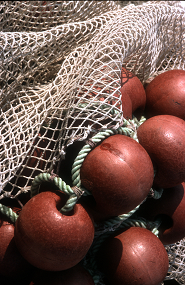In the competition for marine space, the fishing sector needs to prepare for management impacts from other directives than the EU Common Fishery Policy. Our purpose is to support the sector-specific stakeholders and policymakers and provide them with a tool for evaluating the spatial planning and management scenarios and spatial explicit fishery dynamics. This tool is informed by the different types of fishing activities and other activities occupying marine space. Continue reading “Impact assessment of spatial planning on the fishery economy and ecosystems”
Tag: fisheries
Participatory modeling of fisheries for supporting maritime spatial planning
 Modelling the interactions between fishery and stock dynamics as well as the economic fishery importance on a highly spatial disaggregated scale like in DISPLACE, is useful in context of broader spatial planning, marine management, and stakeholder involvement.
Modelling the interactions between fishery and stock dynamics as well as the economic fishery importance on a highly spatial disaggregated scale like in DISPLACE, is useful in context of broader spatial planning, marine management, and stakeholder involvement.
It is important to develop supporting tools for impact evaluations that can inform all parties (scientists, stakeholders, and managers) on the overall fishing sector dynamics on a highly disaggregated scale to develop a collective understanding and common discussion platform based on quantitative predictions of impacts and beneficial/detrimental effects of any new spatial marine planning project . As such, the DISPLACE model can be used to obtain further information on fishermen behavior with direct input from stakeholders (e.g., here).
 Such an approach should foster management choices to be based on a more objective and transparent basis and on actual feedback from the stakeholders when they react to spatial planning. More participatory management requires quantitative support and a common platform for input that will likely promote good fishing practices and achieve better compliance with the regulations and where stakeholders can feel more engaged in the ecosystem-based fisheries management decision process (also advocated here).
Such an approach should foster management choices to be based on a more objective and transparent basis and on actual feedback from the stakeholders when they react to spatial planning. More participatory management requires quantitative support and a common platform for input that will likely promote good fishing practices and achieve better compliance with the regulations and where stakeholders can feel more engaged in the ecosystem-based fisheries management decision process (also advocated here).
The goal is to also inform managers with quantitative supports about the potential gain of spatial regulations against the cost for displacement when fishermen loose access to valuable fishing grounds and/or have to travel more to go fishing from their home harbor to make a living out of the catches.
High-resolution mapping of fishing activities: toward well-informed marine spatial planning
Multi-sectoral and multi-disciplinary marine spatial planning methods are prevailing in the EU Marine Strategy Framework Directive. Such integrated marine management needs to consider the commercial fishery and all other sector uses of the sea, such as transport, energy exploitation and recreational use.
Consequently, each of these pressures on the marine ecosystem needs to be mapped.
 Annual average fishing intensity (2010-2012) at the surface level (left; sediment abrasion < 2cm) and subsurface level (right; abrasion ≥ 2 cm) for all bottom contacting gears from Denmark, Sweden and Germany. (Source: here)
Annual average fishing intensity (2010-2012) at the surface level (left; sediment abrasion < 2cm) and subsurface level (right; abrasion ≥ 2 cm) for all bottom contacting gears from Denmark, Sweden and Germany. (Source: here)
Simultaneously, the EU Common Fisheries Policy recently recognized the importance of accounting for heterogeneity in fishing practices from different fleets for managing
commercial fisheries. It was acknowledged that a shift should take place from managing individual fish stocks towards managing fleets, mixed fisheries, and economic issues.
Fine-grained VMS data enable obvious improvements to describe used areas and spatial fishing pressure with higher resolution than the ICES rectangles. Hence, the linkage of VMS with logbooks constitutes very valuable information for mapping the spatiotemporal heterogeneity of landings and economically important fishing grounds to act as the basis for management decisions and designation of priorities areas.
 These maps can be used directly for conditioning the DISPLACE model and inform area-based management performing strategy evaluation and scenario modelling of different management options associated with, for example, the establishment of spatial regulated areas and displacement of fishing effort in relation to ecosystem conditions (sensitive habitats), variability in fish stock occurrence and other uses of the sea.
These maps can be used directly for conditioning the DISPLACE model and inform area-based management performing strategy evaluation and scenario modelling of different management options associated with, for example, the establishment of spatial regulated areas and displacement of fishing effort in relation to ecosystem conditions (sensitive habitats), variability in fish stock occurrence and other uses of the sea.
Impact assessment of windmill parks on fisheries
 An on-going work is to apply and downscale the DISPLACE model to the commercially important and busy Western Baltic marine area where several utilisations of the sea currently coexist. In line with this it is evaluated to which extent the international plans for offshore windmill parks in the Baltic area are affecting the fishing opportunities per activity and fishing communities in the vicinity of the planned windmill sites.
An on-going work is to apply and downscale the DISPLACE model to the commercially important and busy Western Baltic marine area where several utilisations of the sea currently coexist. In line with this it is evaluated to which extent the international plans for offshore windmill parks in the Baltic area are affecting the fishing opportunities per activity and fishing communities in the vicinity of the planned windmill sites.
Hence, preliminary data mining shows that the planned offshore windmill parks in the area do not really interfere with important fishing grounds for the Danish fisheries. Continue reading “Impact assessment of windmill parks on fisheries”
